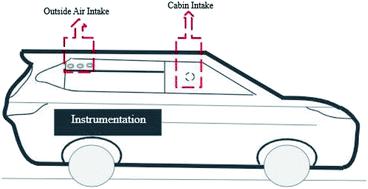当前位置:
X-MOL 学术
›
Environ. Sci.: Processes Impacts
›
论文详情
Our official English website, www.x-mol.net, welcomes your
feedback! (Note: you will need to create a separate account there.)
Behavior of carbon monoxide, nitrogen oxides, and ozone in a vehicle cabin with a passenger
Environmental Science: Processes & Impacts ( IF 4.3 ) Pub Date : 2021-1-4 , DOI: 10.1039/d0em00395f David Mendez-Jimenez 1, 2, 3, 4, 5 , Pascale S. J. Lakey 2, 4, 6, 7 , Manabu Shiraiwa 2, 4, 6, 7 , Heejung Jung 1, 2, 3, 4, 5
Environmental Science: Processes & Impacts ( IF 4.3 ) Pub Date : 2021-1-4 , DOI: 10.1039/d0em00395f David Mendez-Jimenez 1, 2, 3, 4, 5 , Pascale S. J. Lakey 2, 4, 6, 7 , Manabu Shiraiwa 2, 4, 6, 7 , Heejung Jung 1, 2, 3, 4, 5
Affiliation

|
Drivers and passengers are exposed to high concentrations of air pollutants while driving. While there are many studies to assess exposure to air pollutants penetrating into a vehicle cabin, little is known about how individual gas pollutants are behaving (e.g. accumulating, depositing, reacting etc.) in the cabin. This study investigated the characteristic behavior of CO, NO, NO2 and O3 in a vehicle cabin in the presence of a driver with static, pseudo dynamic and dynamic tests. We found in our experiments that CO and NO concentrations increased while O3 and NO2 concentrations decreased rapidly when cabin air was recirculated. A kinetic model, which contains 20 chemical reactions, could predict the static test results well. CO and NO accumulations in the cabin were due to exhalation from the driver and conversion of NO2 to NO upon deposition to surfaces may also play a role. Pseudo dynamic and dynamic test results showed similar results. During the fresh air mode CO, NO, and NO2 followed similar trends between the inside and outside of the cabin, while in cabin O3 concentrations were lower compared to outside concentrations due to reactions with the human and surface deposition. The Cabin Air Quality Index approached 0.8 and 0.4 for O3 during pseudo dynamic and dynamic tests, respectively. Accumulation of NO in the cabin was not obvious during the dynamic test due to a large variation of outside NO concentrations. We encourage auto manufacturers to develop control algorithms and devices to reduce a passenger's exposure to gaseous pollutants in vehicle cabins.
中文翻译:

一氧化碳,氮氧化物和臭氧在带有乘客的车厢中的行为
驾驶员和乘客在驾驶时会暴露于高浓度的空气污染物中。尽管有许多研究评估暴露于进入车厢的空气污染物的暴露程度,但对于单个气体污染物在车厢内的行为方式(例如积累,沉积,反应等)知之甚少。这项研究通过静态,伪动态和动态测试研究了驾驶员在场的情况下车厢中CO,NO,NO 2和O 3的特征行为。我们在实验中发现,CO和NO浓度增加,而O 3和NO 2当机舱空气再循环时,浓度迅速下降。包含20个化学反应的动力学模型可以很好地预测静态测试结果。机舱中的CO和NO积累是由于驾驶员的呼气所致,并且在沉积到表面时将NO 2转化为NO也可能起作用。伪动态和动态测试结果显示了相似的结果。在新鲜空气模式下,机舱内部和外部之间的CO,NO和NO 2遵循相似的趋势,而机舱中O 3的浓度低于外界浓度,这是由于与人体和表面沉积物的反应。O 3的客舱空气质量指数接近0.8和0.4在分别进行伪动态和动态测试时。在动态测试过程中,由于外部NO浓度变化很大,机舱中NO的积累并不明显。我们鼓励汽车制造商开发控制算法和设备,以减少乘客暴露在车厢内的气态污染物。
更新日期:2021-01-15
中文翻译:

一氧化碳,氮氧化物和臭氧在带有乘客的车厢中的行为
驾驶员和乘客在驾驶时会暴露于高浓度的空气污染物中。尽管有许多研究评估暴露于进入车厢的空气污染物的暴露程度,但对于单个气体污染物在车厢内的行为方式(例如积累,沉积,反应等)知之甚少。这项研究通过静态,伪动态和动态测试研究了驾驶员在场的情况下车厢中CO,NO,NO 2和O 3的特征行为。我们在实验中发现,CO和NO浓度增加,而O 3和NO 2当机舱空气再循环时,浓度迅速下降。包含20个化学反应的动力学模型可以很好地预测静态测试结果。机舱中的CO和NO积累是由于驾驶员的呼气所致,并且在沉积到表面时将NO 2转化为NO也可能起作用。伪动态和动态测试结果显示了相似的结果。在新鲜空气模式下,机舱内部和外部之间的CO,NO和NO 2遵循相似的趋势,而机舱中O 3的浓度低于外界浓度,这是由于与人体和表面沉积物的反应。O 3的客舱空气质量指数接近0.8和0.4在分别进行伪动态和动态测试时。在动态测试过程中,由于外部NO浓度变化很大,机舱中NO的积累并不明显。我们鼓励汽车制造商开发控制算法和设备,以减少乘客暴露在车厢内的气态污染物。











































 京公网安备 11010802027423号
京公网安备 11010802027423号